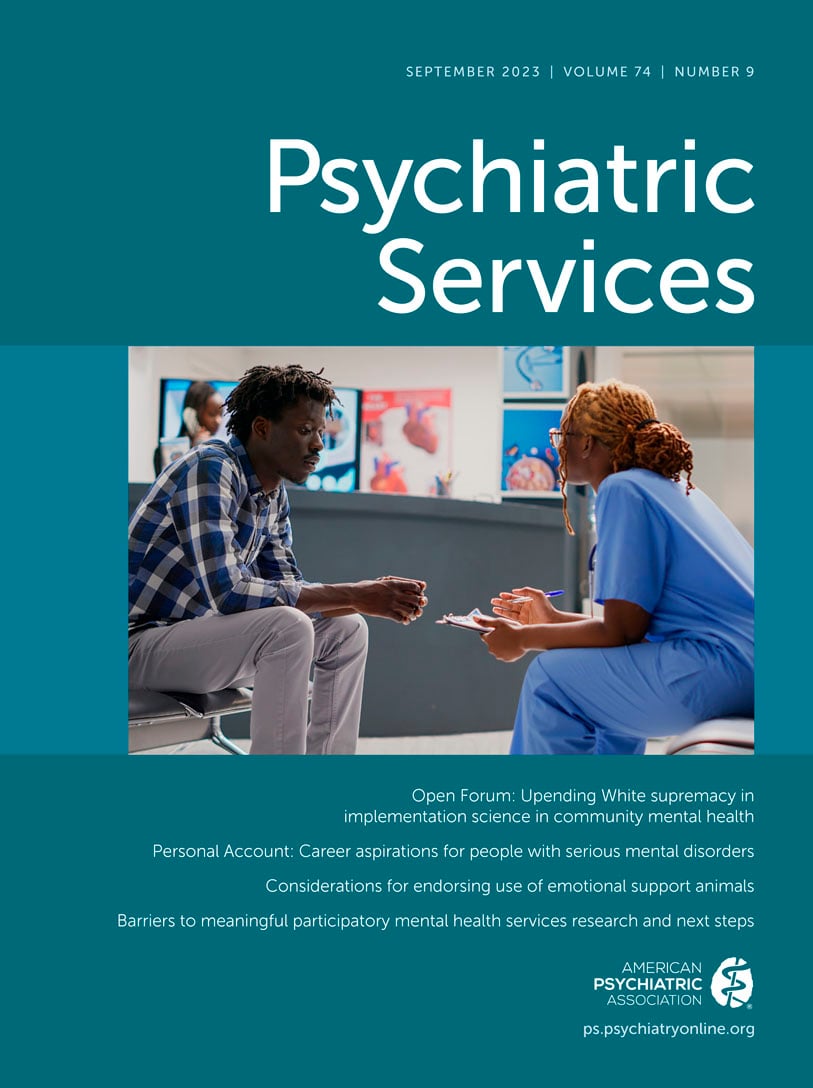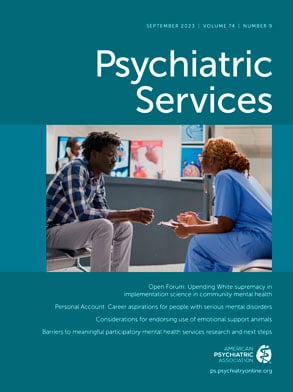Although limited research has substantiated the use of emotional support animals (ESAs) to alleviate psychiatric symptoms, clinicians may be asked to write a certification letter to endorse a patient’s request to designate their pet as an ESA. Federal, state, and local laws that regulate ESAs vary. Because this area of clinical practice and regulation is evolving, psychiatrists who are contemplating whether they should write a letter endorsing use of an ESA must stay up to date with laws in their jurisdiction. This article provides an overview of definitions and terminology; federal, state, and local laws related to ESAs; and clinical, ethical, and liability issues that psychiatrists should consider when they are asked to write an ESA letter for a patient.
Clinical Issues
To date, the evidence base is limited regarding the clinical benefits of ESAs for psychiatric symptoms or disorders (
14). One pre-post study of 11 participants with serious mental illness reported significant reductions in loneliness, depression, and anxiety symptoms 12 months after they started living with an ESA. However, the study did not control for other psychiatric treatments received during the study period (
15). Another study currently under way is examining the use of ESAs as treatment for veterans with posttraumatic stress disorder (PTSD) (
16).
Given the paucity of evidence regarding ESAs for psychiatric symptoms or disorders, inferences may be made from studies that have examined the impact of service and therapy animals, which differ from ESAs in that they must undergo specialized training. These studies show mixed evidence for the utility of service and therapy animals for psychiatric conditions, including PTSD (
17,
18), anxiety (
19,
20), dementia (
21), autism spectrum disorder (
22,
23), and schizophrenia (
24,
25). In addition, these studies are small, underpowered, and lack a randomized controlled trial design. Further inferences can be made from the effects of pet ownership. Pet ownership may be associated with reduced cardiovascular disease risk (
26) and improved general medical and psychological well-being (
27). Proposed mechanisms underlying these associations include increased social support (
28) and facilitation of social interactions (
29–
31). Other studies propose that no direct association exists between pet ownership and benefits to human health, but rather that cofactors, including owners’ personality traits, age, economic status, and health status, produce an apparent link between pet ownership and health (
32). Qualitative reports suggest that pets may positively contribute to the management of mental health symptoms (
3,
32). However, it is also important to consider the practical and emotional burdens of pet ownership and the psychological impact of pet loss (
3,
32).
Few formal training opportunities are available for ESA certification, and many of them are produced by “lay animal enthusiasts and organizations, which can lead to bias” (
3). This paucity is problematic because 35.7% of mental health providers reported feeling unqualified to make an ESA determination (
33). However, several authors have recently proposed practice guidelines for mental health providers to determine whether patients would benefit from an ESA (
15,
34).
Younggren et al. (
34) assert that clinicians should consider whether an animal has the appropriate temperament, disposition, and training to be an ESA. For example, is a dog able to provide calming effects for its owner when taken into a strange place, such as a crowded airport, or is it going to be scared enough to become aggressive, thereby worsening the patient’s anxiety? Furthermore, they recommend obtaining collateral information from a certification program (e.g., the Canine Good Citizen test), an animal behaviorist, or a veterinarian in order to understand the animal’s temperament (
34). They add that clinicians should directly assess the patient-pet interaction to determine whether a pet is able to ameliorate its owner’s mental health impairments (
34). In contrast, Hoy-Gerlach et al. (
15) state that a clinician does not need to meet an animal or witness patient-animal interactions to make a determination of ESA suitability. They suggest that a clinician may acceptably rely on a patient’s self-report, similar to evaluating standard interventions such as coping strategies or mindfulness practices (
15). Because clinicians are not trained to assess an animal’s temperament, evaluating an animal’s suitability as an ESA is outside their area of expertise.
The two recommended components of an ESA evaluation are, first, to determine whether a patient has a chronic mental impairment caused by a psychiatric condition (as defined by the
DSM-5-TR) that substantially limits their functioning in one or more domains (i.e., a disability) and, second, to determine whether the ESA will alleviate such an impairment (
3,
14).
Definitions of
psychiatric disability and
impairment alleviation can help clarify these recommendations. The Practice Resource for the Forensic Evaluation of Psychiatric Disability from the American Academy of Psychiatry and the Law (
35) indicates that during a disability evaluation, a psychiatrist must link a patient’s chronic mental impairments to a mental disorder. The psychiatrist should also consider explanations for the reported disability other than a mental disorder, including by assessing for malingering, and conduct an evaluation that includes a psychiatric interview, a review of general medical and psychiatric treatment records, and collateral information. Regarding impairment alleviation, Younggren et al. (
34) suggest that “disability does not mean the individual has an attachment to the ESA, feels happier in proximity to the ESA, or just wants to accompany the animal, which is usually their pet. It means that the person requires the presence of the animal to function or remain psychologically stable.”
Clinicians should also consider a patient’s ability to care for their animal (
15,
34) and the ability of the animal to serve in an ESA role (
3,
14). Furthermore, as discussed earlier, clinicians writing ESA certification letters should be aware of variability in state requirements for these evaluations. For example, a clinician must know whether a state requires that the letter writer have an established relationship with a patient or meet with that patient in person or whether it is acceptable to refer a patient for a forensic evaluation to determine the need for an ESA.
In general, minimally necessary clinical information should be included in these letters to protect patient confidentiality. The letter should specify whether the animal is expected to alleviate impairing psychiatric symptoms. Hoy-Gerlach et al. (
15) suggest that psychiatrists review all such letters every 6 months and update them as needed to ensure that ESAs are providing continual therapeutic benefits.
Ethical Considerations
Clinicians who are contemplating writing an ESA letter should be aware of several ethical considerations. It is unethical and illegal to engage in disability fraud by writing ESA letters simply to allow patients to bring pets to venues that are not pet friendly, to avoid fees associated with having a pet, or to override restrictions on breeds and species (
36). Misusing ESA certifications as legal loopholes “negatively impacts the public’s perception of the disabled” (
37), undermining justice for patients who genuinely require an animal’s support. Given the limited evidence supporting the effective use of an ESA—even when a patient has a genuine psychiatric disability—it is ethically permissible to decline to write an ESA letter.
Clinicians can think of an ESA as an unconventional and unproven treatment to target mental health symptoms that cause functional impairment. As with any unproven treatment, clinicians should carefully weigh the relevant risks and benefits of an ESA for each patient, considering the paucity of evidence that supports the use of ESAs. Unlike most conventional treatments, an ESA directly affects not only a patient but also individuals around that patient. Therefore, although a treating clinician’s primary obligation is to their patient, they should also consider their secondary obligations to public health when deciding whether to write an ESA letter (
3).
Another ethical consideration is the role conflict that arises when a treating clinician deviates from their traditional role as patient advocate to conduct an ESA evaluation (
34). ESA evaluations are essentially disability evaluations. Boness et al. (
33) assert that these evaluations should be conducted in the same rigorous manner as other disability evaluations, including assessments of malingering. Others have stated that writing an ESA is “not a stand-alone administrative task like a disability determination, but rather an active intervention based on a clinical rationale” (
15). To eliminate the ethical concern about conflict between the roles of clinician and evaluator, some authors argue that, if resources are available, forensic psychiatrists or psychologists are best equipped to conduct these evaluations (
3,
34). However, in some jurisdictions, laws require that the letter writer have an established relationship with a patient, and referral to a forensic evaluator is not permitted.
As with any forensic evaluation, whether completed by a treating clinician or a forensic evaluator, the evaluator should assess their own biases and strive for objectivity. If a patient’s treating clinician performs the evaluation, they should consider the effects that an assessment that does not support their patient’s wishes might have on the therapeutic relationship (
34). It is also important for clinicians to be aware of the potential harms associated with writing a letter that they do not totally support. If a patient knows that their clinician does not believe what they are writing, then the clinician’s credibility is undermined and the patient may lose trust in the provider (
36).

